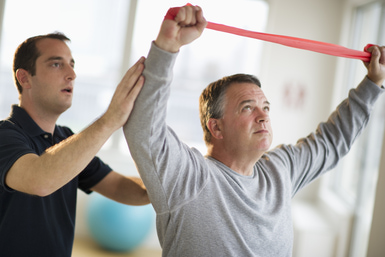Are you a fitness enthusiast or a dedicated athlete who has suddenly been sidelined by a nagging, persistent pain in your calf and ankle? That sharp or aching sensation that flares up during or after activity could be the result of Achilles tendonitis. The Achilles...
We’ve all seen soccer players sidelined by common but painful injuries like ankle sprains, knee ligament tears, and muscle strains. The combination of running, sudden stops, quick cuts, and potential physical contact makes the body, particularly the lower extremities,...
Spinal cord injuries are among the most serious and life-altering injuries a person can sustain. The spinal cord, a complex bundle of nerves, is the primary pathway for communication between the brain and the rest of the body. When it’s damaged, a patient could be...
Nonoperative Shoulder Rehabilitation

Dealing with a shoulder injury can affect every aspect of your daily life and can make certain activities almost impossible. Fortunately, there are ways to deal with shoulder injuries that don’t require surgery. Explore nonoperative options first so you can hopefully avoid surgery and a lengthy healing period.
Shoulder rehabilitation is effective in treating many different shoulder injuries and disorders such as fractures, joint instability, joint impingement, frozen shoulder, and dislocation. It involves a series of exercises and stretches over a period of time that slowly strengthens your shoulder. When performed properly, rehabilitation helps you regain range of motion in the shoulder so you’re able to use it as you once did.
After the Injury
Immediately following an injury, it’s crucial that you see a doctor or visit an emergency room if you feel a lot of pain. The doctor will evaluate your medical history and examine
your shoulder to diagnose the specific injury.
In some cases, such as a fracture, the shoulder needs to be stabilized to allow it time to heal before beginning a rehabilitation program.
Rehabilitation Program
Your physician will develop a rehabilitation plan tailored to your specific needs. The program will factor in your injury, lifestyle, medical history, and body type, among other considerations.
A rehabilitation program for a shoulder injury typically follows four phases, but the time frame will vary from one patient to another.
Phase I: (0-4 weeks)
During phase I, the patient will begin with early mobility and passive range of motion stretches that will exercise the shoulder but also be careful not to cause reinjury.
A shoulder pulley is one example of a passive range of motion exercise. This apparatus is hooked over the top of a door with a small pulley system near the top of a rope with handles that hang down from the pulley. You’ll use the pulleys to perform different exercises and improve the range of motion in your shoulders.
Phase II: (4-8 weeks)
Phase II focuses on active range of motion to build your shoulder strength in order to recover normal function. These types of exercises include different movements where you fully extend your arm and perform 8-12 repetitions of each exercise.
Phase III: (8-12 weeks)
As your strength increases, you’ll be able to progress to higher-intensity exercises that rely on your shoulder more. Isotonic exercises work muscle groups through joint movement, and will move the shoulder joint to work the surrounding muscles. Resistance bands can also be used depending on how your shoulder is fairing. These exercises include seated shoulder raises, front raises, and lateral raises.
Phase IV: (return to activity)
Phase IV involves increasing the weight and repetitions of each exercise, and continues to push the range of motion until the patient has full function.
Once a patient can proficiently perform all movements with their shoulder, thephysician will likely clear them to return to regular activity.
If you suffer a shoulder injury, you may be able to treat it with nonoperative shoulder rehabilitation.
For more information about how to treating injuries through non-operative methods,click here to download our eBook, The Patient’s Guide to Non-Operative Care and Rehabilitation.



